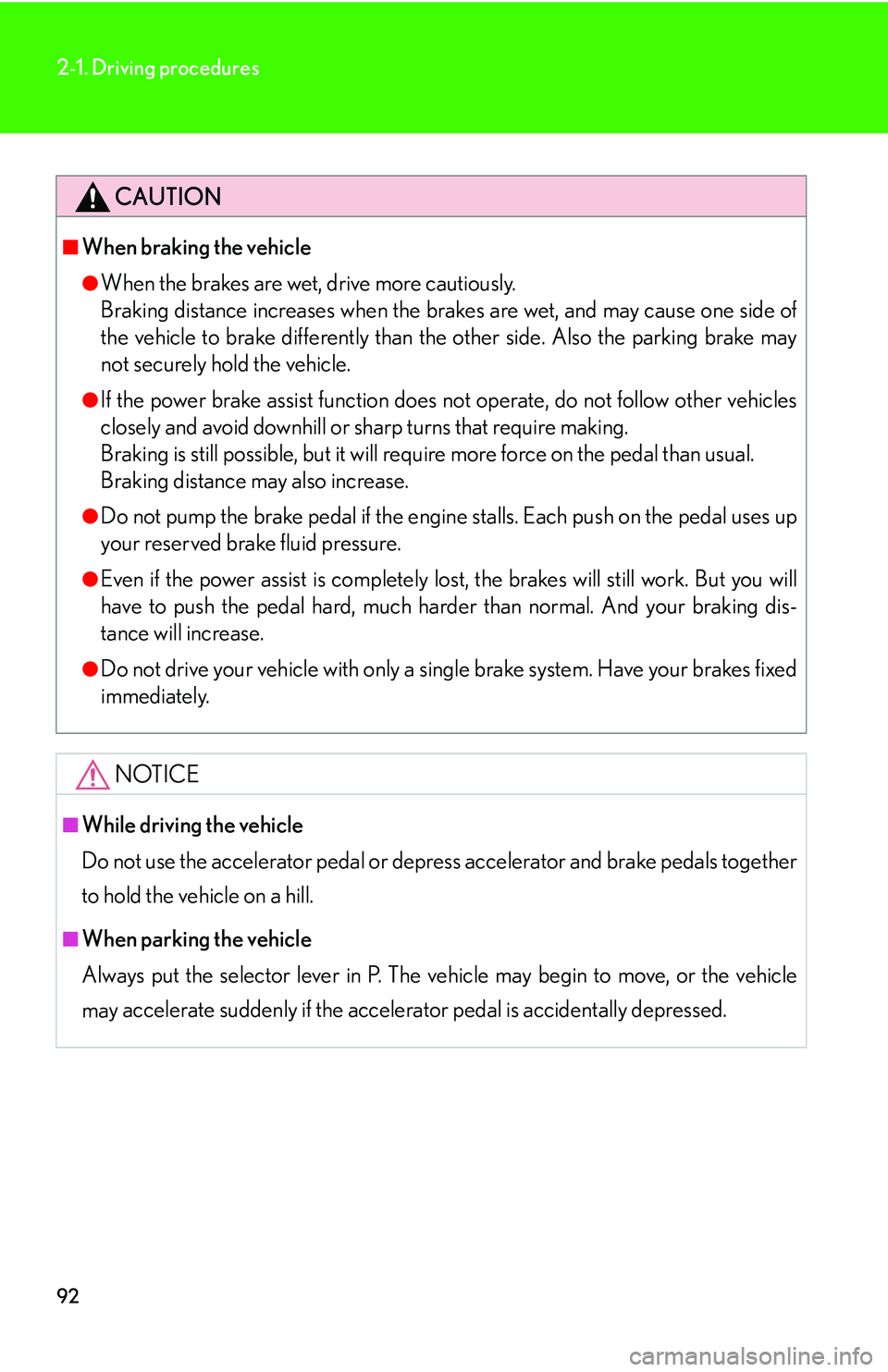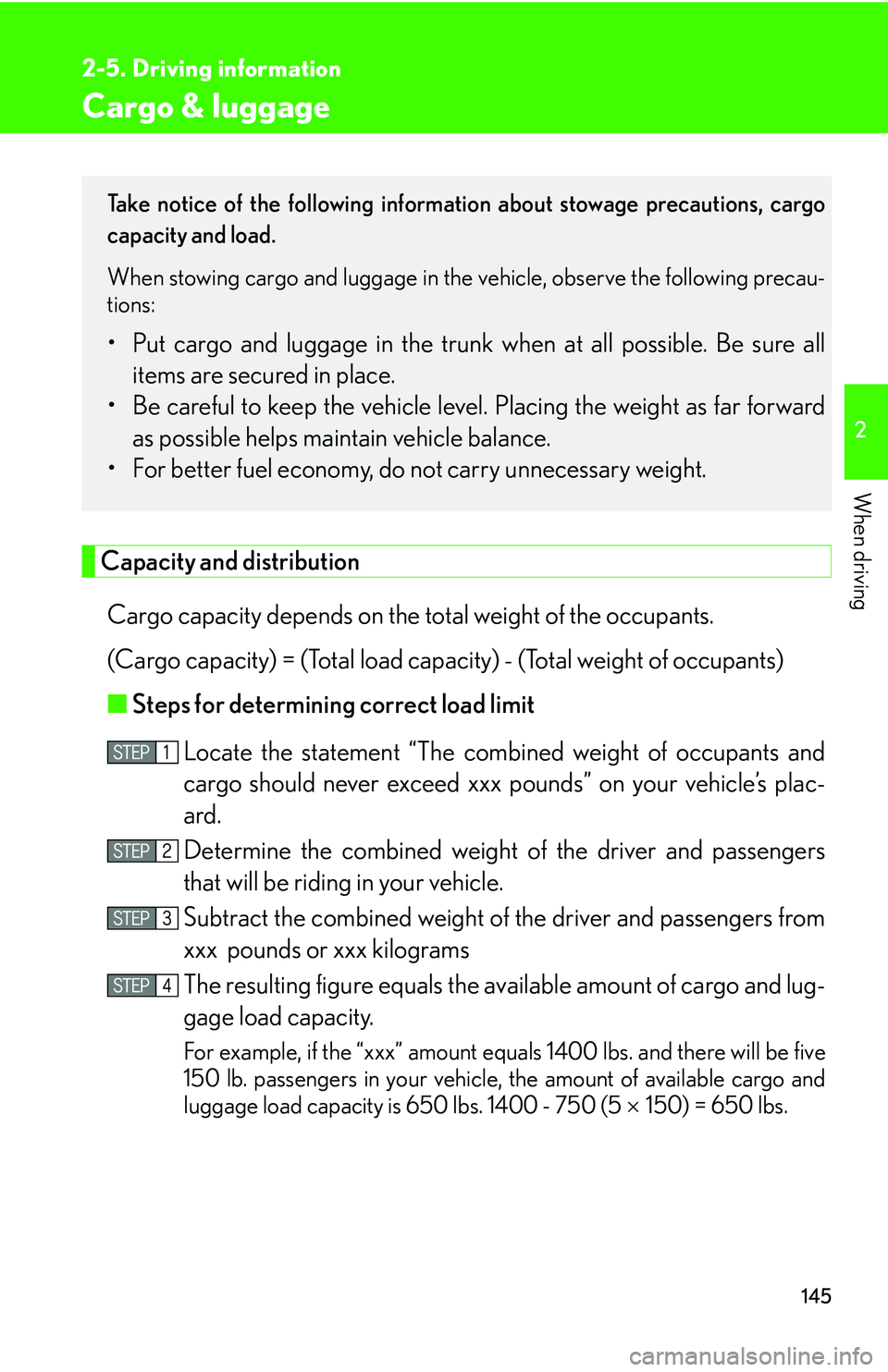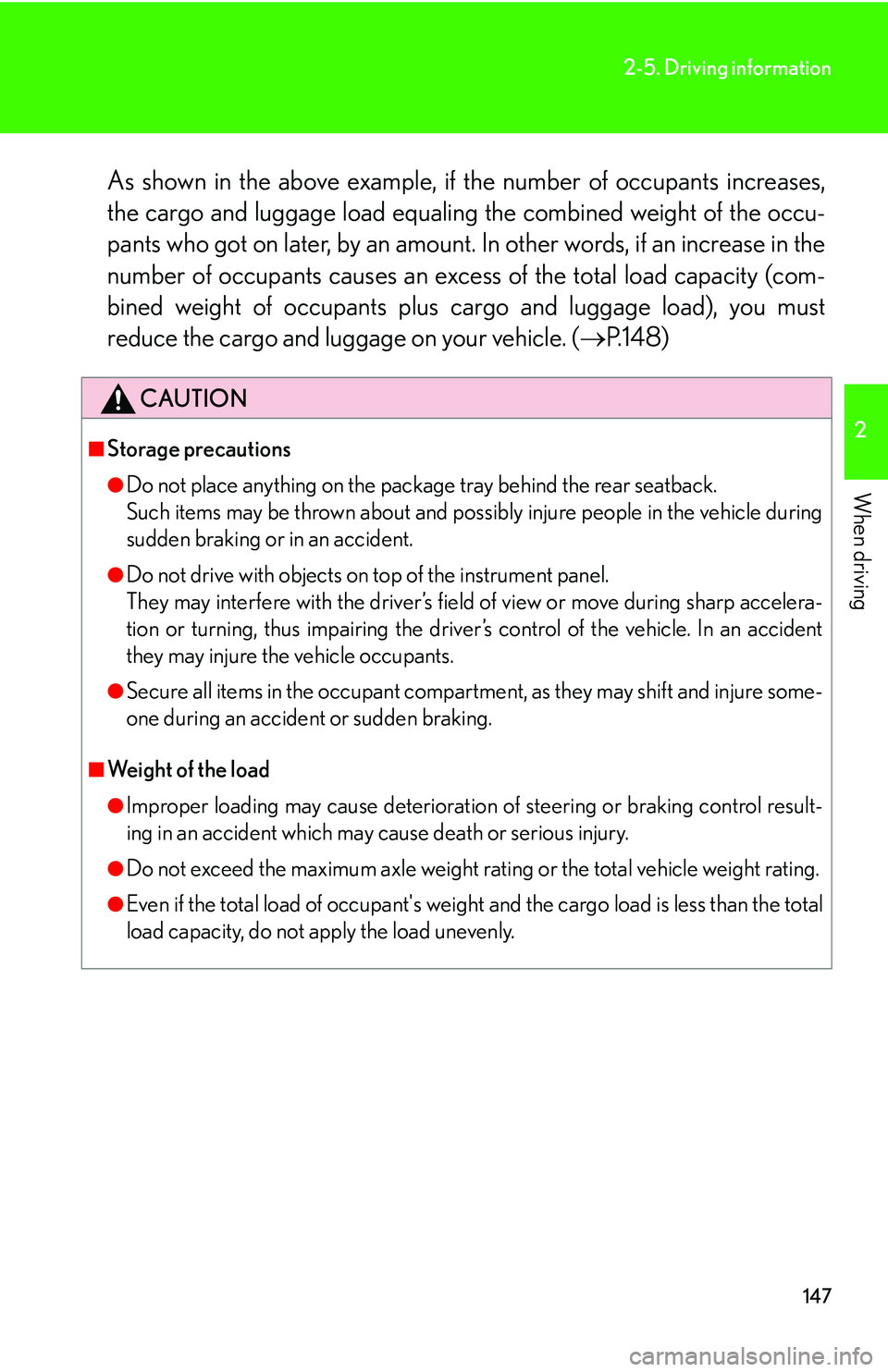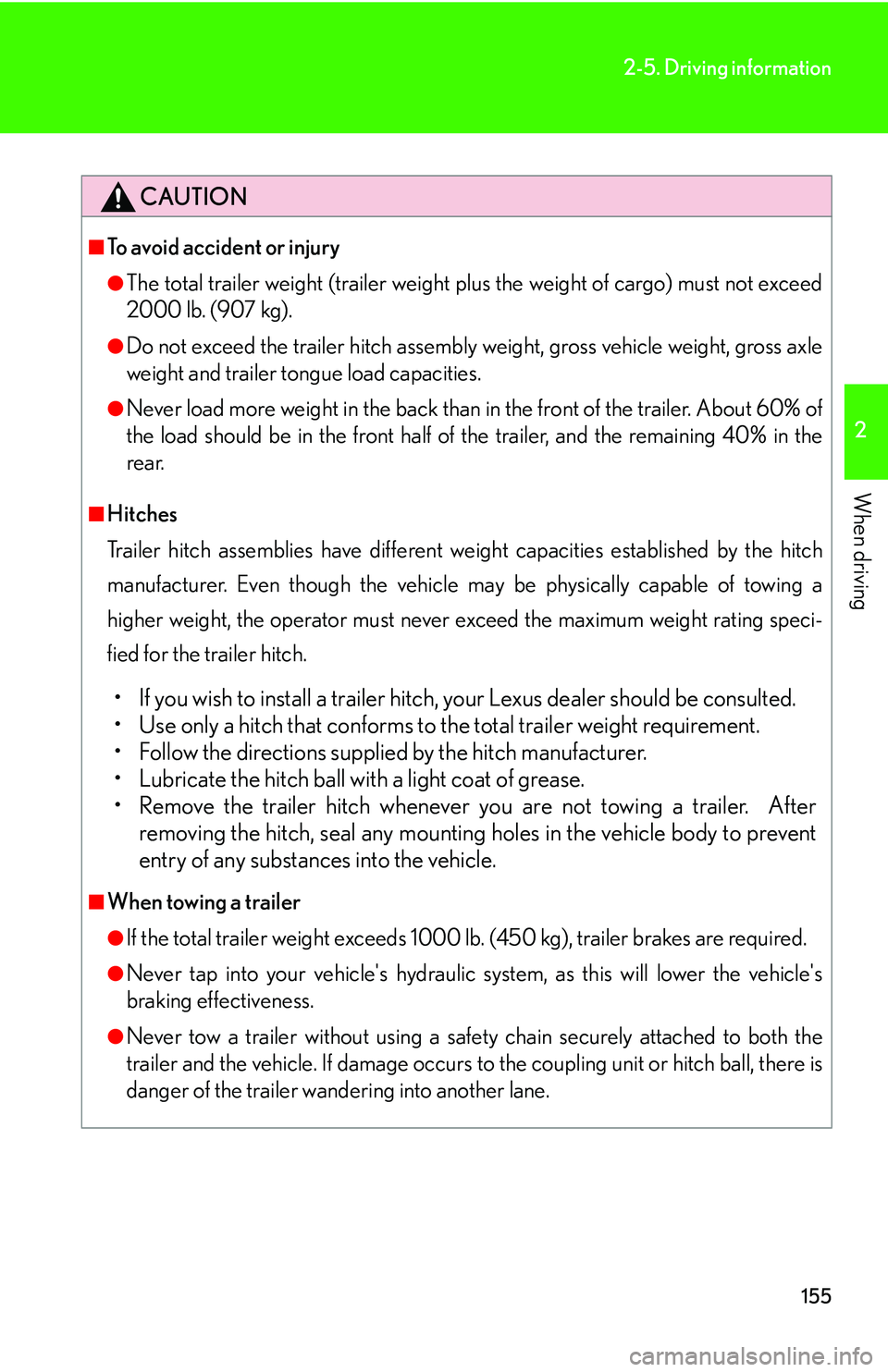Page 100 of 419
84
1-7. Safety information
Type B
Widen the gap between the seat
cushion and seatback slightly
.
Latch the buckles onto the anchor-
ages.
If the child restraint has a top strap, the top strap should be latched onto the
anchorages.
CAUTION
■To install correctly
When using the lower anchorages, be sure that there are no foreign objects around
the ancho
rages and that the seat belt is not caught behind the child seat.
Make sure the restraint system is securely
attached, or it may cause death or seri-
ous injury to the child in the even t of
a sudden stop or accident.
■Child restraint systems that can be installed using the lower anchorages
Child restraint systems conforming to FM V
SS225 or CMVSS210.2 specifications
can be used. This vehicle is designed to confirm to the SAE J1819.
Page 108 of 419

92
2-1. Driving procedures
CAUTION
■When braking the vehicle
●When the brakes are wet, drive more cautiously.
Braking distance increases when the brakes are wet, and may cause one side of
th
e vehicle to brake differently than the other side. Also the parking brake may
not securely hold the vehicle.
●If the power brake assist function does not operate, do not follow other vehicles
closely and avoid downhill or sharp turns that require making.
Braking is still possible, but it will re quir
e more force on the pedal than usual.
Braking distance may also increase.
●Do not pump the brake pedal if the engine stalls. Each push on the pedal uses up
your reserved brake fluid pressure.
●Even if the power assist is completely lost, the brakes will still work. But you will
have to push the pedal hard, much hard er than normal. And your braking dis-
tance will increase.
●Do not drive your vehicle with only a single brake system. Have your brakes fixed
immediately.
NOTICE
■While driving the vehicle
Do not use the accelerator pedal or depres s acceler
ator and brake pedals together
to hold the vehicle on a hill.
■When parking the vehicle
Always put the selector lever in P. The vehicle may begin to move, or the vehicle
ma
y accelerate suddenly if the accelerat or pedal is accidentally depressed.
Page 140 of 419
124
2-4. Using other driving systems
■Rear view monitor system camera
■Smear effect
In the following cases, it may become difficult
to see the images on the screen, even when
the system is functioning correctly.
• In the dark (e.g., at night).
• If the temperature near the lens is extremely high or low.
• If water droplets adhere to the camera, or when humidity is high (e.g., when it rains).
• If foreign matter (e.g., snow or mud) adheres to the camera lens.
• If the sun or headlights are shining directly
into the camera lens.
If a bright light (for example, sunlight
reflected off the vehicle body) is picked up by
the camera, a smear effect* peculiar to the
camera may occur.
*: Smear effect-A phenomenon that occurs when a bright light (for example, sunlight
reflected off the vehicle body) is picked up
by the camera; when transmitted by the
camera, the light source appears to have a
vertical streak above and below it.
Page 161 of 419

145
2
When driving
2-5. Driving information
Cargo & luggage
Capacity and distribution
Cargo capacity depends on the total weight of the occupants.
(Cargo capacity) = (Total load capacity) - (T
otal weight of occupants)
■ Steps for determining corr
ect load limit
Locate the statement “The combin ed w
eight of occupants and
cargo should never exceed xxx pounds” on your vehicle’s plac -
ard.
Determine the combined weight of the driv
er and passengers
that will be riding in your vehicle.
Subtract the combined weight of the driver and passengers from
xxx pounds or xxx kilograms
The resulting figure equals the available amount of car
go and lug-
gage load capacity.
For example, if the “xxx” amount equa ls 1400 lbs. and there will be five
150 lb. passengers in your vehicle, the amount of available cargo and
luggage load capacity is 650 lbs. 1400 - 750 (5 150) = 650 lbs.
Take notice of the following information about stowage precautions, cargo
capacity and load.
When stowing cargo and luggage in the vehicle, observe the following precau-
tions:
• Put cargo and luggage in the trunk wh en at all possible. Be sure all
items are secured in place.
• Be careful to keep the vehicle level. Placing the w
eight as far forward
as possible helps maintain vehicle balance.
• For better fuel economy, do not carry unnecessary weight.
Page 163 of 419

147
2-5. Driving information
2
When driving
As shown in the above example, if the number of occupants increases,
the cargo and luggage load equaling the combined weight of the occu-
pants who got on later, by an amount. In other w
ords, if an increase in the
number of occupants causes an excess of the total load capacity (com -
bined weight of occupants plus car go and luggage load), y
ou must
reduce the cargo and luggage on your vehicle. ( P.148 )
CAUTION
■Storage precautions
●Do not place anything on the packag e tray behind the rear seatback.
Such items may be thrown about and possib ly injur
e people in the vehicle during
sudden braking or in an accident.
●Do not drive with objects on top of the instrument panel.
They may interfere with the driver’s field of view or move during sharp accelera -
tion or turning, thus impairing the driver ’
s control of the vehicle. In an accident
they may injure the vehicle occupants.
●Secure all items in the occupant compartment, as they may shift and injure some -
one during an accident or sudden braking.
■Weight of the load
●Improper loading may cause deterioratio n of steering or braking control result-
ing in an accident which may cause death or serious injury.
●Do not exceed the maximum axle weight ra ting or the total vehicle weight rating.
●Even if the total load of occupant's weight and the cargo load is less than the total
load capacity, do not apply the load unevenly.
Page 170 of 419

154
2-5. Driving information
■Before towing
●Ensure that your vehicle’s tires are properly inflated. (P.283 )
●Trailer tires should be inflated according to the trailer manufacturer’s recom -
mendation.
●All trailer lights must work to be legal.
●Confirm all lights work each time you connect them.
●Check that your vehicle remains level when a loaded or unloaded trailer is
hitched. Do not drive if the vehicle is not level, and check for improper tongue
load, overloading, worn suspension, or other possible causes.
●Make sure the trailer cargo is securely loaded.
●Check that your rear view mirrors conform to any federal, state/provincial or
local regulations. If they do not, instal l rear view mirrors appropriate for towing
purposes.
■Break-in schedule
Lexus recommends that you do not use a new vehicle or a vehicle with any new
p
ower train components (engine, transmissi on, differential, wheel bearing, etc.) to
tow a trailer for the first 500 miles (800 km) of driving.
■Maintenance
●If you tow a trailer, your vehicle will require more frequent maintenance due to
the additional load. (see “Owner’s Manual Supplement/ Scheduled Mainte -
nance”)
●Retighten the fixing bolts of the towing ball and bracket after approximately
600 miles (1000 km) of trailer towing.
Page 171 of 419

155
2-5. Driving information
2
When driving
CAUTION
■To avoid accident or injury
●The total trailer weight (trailer weight plus the weight of cargo) must not exceed
2000 lb. (907 kg).
●Do not exceed the trailer hitch assembly weight, gross vehicle weight, gross axle
weight and trailer tongue load capacities.
●Never load more weight in the back than in the front of the trailer. About 60% of
the load should be in the front half of the trailer, and the remaining 40% in the
rear.
■Hitches
Trailer hitch assemblies have different weight capacities established by the hitch
ma
nufacturer. Even though the vehicle may be physically capable of towing a
higher weight, the operator must never exceed the maximum weight rating speci -
fied for the trailer hitch.
• If you wish to install a trailer hitch, your Lexus dealer should be consulted.
• Use only a hitch that conforms to the total trailer weight requirement.
• Follow the directions supplied by the hitch manufacturer.
• Lubricate the hitch ball with a light coat of grease.
• Remove the trailer hitch whenever you are not towing a trailer. After r
emoving the hitch, seal any mounting holes in the vehicle body to prevent
entry of any substances into the vehicle.
■When towing a trailer
●If the total trailer weight exceeds 1000 lb . (450 kg), trailer brakes are required.
●Never tap into your vehicle's hydraulic system, as this will lower the vehicle's
braking effectiveness.
●Never tow a trailer without using a safety chain securely attached to both the
trailer and the vehicle. If damage occurs to the coupling unit or hitch ball, there is
danger of the trailer wandering into another lane.
Page 196 of 419

180
3-2. Using the audio system
■If the satellite radio tuner malfunctions
If a problem occurs with the XM tuner
, a message will appear on the
display. Referring to the table below to identify the problem, take the
suggested corrective action.
Contact the XM Listener Care Center at (800) 852-9696 during the fol -
lowing hours*.
Monday - Saturday: 7 a.m. - 2 a.m. Sunday: 7 a.m. - 7 p.m. Central Standard
Ti
m e
* Subject to change without notice.
ANTENNA
The XM antenna is not connected. Check whether the XM
antenna cable is attached securely.
There is a short-circuit in th e antenna or the surrounding
antenna cable. See a Lexus certified dealer.
UPDATING
You have not subscribed to the XM satellite radio. The radio
is being updated with the latest encryption code. Contact
the XM satellite radio for subscr iption information. When a
contact is canceled, you can choose the “CH000” and all
free-to-air channels.
The premium channel you selected is not authorized. Wait
for about 2 seconds until the radio returns to the previous
channel or “CH001”. If it does not change automatically,
select another channel. If you want to listen to the premium
channel, contact the XM satellite radio.
NO SIGNALThe XM signal is too weak at the current location. Wait until
your vehicle reaches a location with a stronger signal.
LOADIN GThe unit is acquiring audio or program information. Wait until
the unit has received the information.
OFF AIRThe channel you selected is not broadcasting any program -
ming. Select another channel.
-----
There is no song/program title or artist name/feature associ -
ated with the channel at that time.
No action needed.
---
The channel you selected is no longer available. Wait for
about 2 seconds until the radio returns to the previous chan -
nel or “CH001”. If it does not change automatically
, select
another channel.